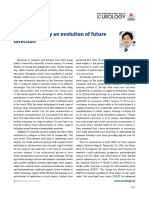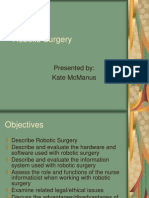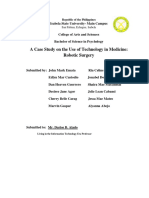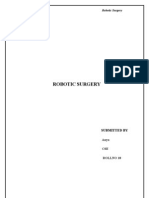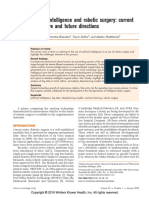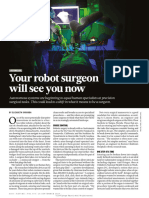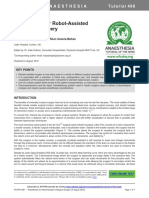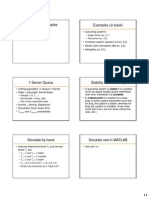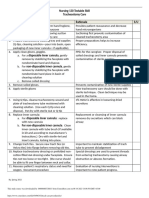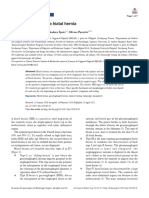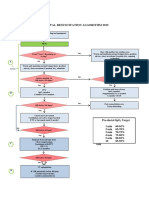Role of computer assisted surgery in the present & Future
Khurshid A Guru Director, Robotic Surgery Assistant Professor of Surgical Oncology University of Buffalo Roswell Park Cancer Institute, NY
Begos DG. Et al. Laparoscopic cholecystectomy: from gimmick to gold standard..J Clin Gastroenterol. 1994, Dec;19(4).
�Limitations of Conventional Laparoscopy
Maneuverability (Trocar positioning) Vision (Two dimensional on flat screen) Dexterity (Long awkward instruments) Counter-intuitive Movement
�Robotic Utilization
Industrial Use First Robot : 1960 1982: 32,000 in use 1994: 20 Million Surgical Sciences 1989 None First FDA Approval (AESOP) - 1993 Da Vinci System Approval - 2000
Different strokes
�Basics
Tele-operated System Stereoscopic visual display Main Console control handles with direct movement of in vivo instruments
Basics
�Basics
High resolution 3D visualization Fully articulating EndoWrist instruments Intuitive movement, motion scaling, tremor reduction
Importance of robotic training for future career goals
Participants interested in pursuing a robotic fellowship
Guru KA, Pavlov S, Kuvshinoff BW, Bienko M, Aftab N, Brady WE, Mohler JL: Impact of Robotics and Laparoscopy on Surgical Skills: A Comparative Study. Journal of American College of Surgeons: January, 2007.
�Star Wars or Lost in Space.
Craig Peters
Proposed Uses
�Requiem to the incision
Transoral robotic surgery (TORS)
Base of tongue tumors (supraglottic carcinoma) 3 human patients Completed robotically Overall Operating Time: 120 minutes No intraoperative complications Technically feasible and safe
Transoral robotic surgery: supraglottic partial laryngectomy. Ann Otol Rhinol Laryngol. 2007;116 (1) 19-23.
�Thoracic experience
University Hospital Innsbruck, Austria Initiated program in 2001 10 thymectomies,16 fundoplications, 4 Esophag. Dissections, 5 Removal of Mediastinal Masses. One Conversion Most elegant to perform Thymectomies
First experience with DaVinci in Thoracic Surgery. European J Cardiothoracic Surg 2004, May 25(5).
Robotic assisted esophagectomy & LN Dissection
21 consecutive patients 18 were thoracoscopic completion Operating time: 180 min (120-240) EBL: 400 ml (150-700) Median LN : 20 Hospital Stay: 18 days ( 11-182) Pulmonary Complications: 48%, One death
First experience with robot assisted thoracoscopic esophagolympadenectomy. Surg.Endoscopy. 2006, Sept 20(9). 1435-9
�Robotic assisted subtotal gastrectomy with extended LN Dissection 7 Patients for early distal gastric tumors Mean age was 64 yrs Median Operating time: 420 min Median LN : 24 ( 17-30), Margin Negative Hospital Stay: 4 days (3- 9) One complication devascularization of Colon No death
Anderson C, Pigazzi A. group COH. Surg.Endoscopy. 2007, March 8
Robot Assisted Splenectomy
7 patients Hematologic disorders & Hypersplenism OR time: 107 +/- 49 minutes No complications No conversions Median hospital stay: 7 days
Laparoscopic spelenectomy with the DaVinci. J Laparoendoscopic Adv Surg Tech.2005, Feb 15(1).
�Robotic assisted Adrenalectomy
30 Patients Mean operating Time: 185 minutes Hospital stay 2 day No intra-operative complication No conversion No robot related complication
Thirty robotic adrenalectomies. Surg Endoscopy 2006,20,119-124.
Robotic assisted laparoscopic hysterectomy
16 Patients Mean Operating time: 242 minutes (170-432) No conversions Mean uterine weight: 131.5 gms Average EBL: 96 ml 1 delayed thermal injury, 2 infections & 1 vaginal cuff hematomas Mean hospital stay 1.5 days
Robotic assisted lap. Hysterectomy. Technique & initial experience. .Am J surgery 2006, 191(4) 555-60.
�Prostate Surgery
Role of Robotics in Prostate Surgery
RPCI completed: 400 Cancer Control Continence Erectile function
�Surgical Margins
N Menon (2005) Patel (2005) Van Appeldorn (2006) 35 200 150 PSM rate (overall) 2% 10.5% 17.3% pT2 (%) 98 78 NR pT3 (%) 2 22 NR Reference (Menon, Kaul et al. 2005) (Patel, Tully et al. 2005) (Van Appledorn, BouchierHayes et al. 2006) (Joseph, Rosenbaum et al. 2006) (Mikhail, Stockton et al. 2006)
Joseph (2006)
325
13%
81
16
Mikhail (2006)
100
16%
79
21
Continence Data
N 3 6 12 mo Continence definition Method of Assessment
Menon, 2003
200
96%
Safety pad
Interview
Ahlering, 2004
90
81%
No pads
Questionnaire
Patel, 2005 Costello, 2005
200 122
82% 73%
89% 82%
98%
No pads Safety pad
Questionnaire Questionnaire
Joseph , 2006
325
93%
96%
No pads
Questionnaire
Mikhail, 2006
100
70%
79%
84%
Return to 75% of baseline
UCLA-PCI
�Sexual Function
N 3 mos 6 mos 12 mos Data source Definition Ref
Menon (2005)
35
97%
IIEF-5
Intercourse
(Menon, Kaul et al. 2005)
Menon (2005)
23
74%
Intercourse
(Menon, Kaul et al. 2005)
Joseph (2006)
325
46%
IIEF-5
IIEF > 21
(Joseph, Rosenbaum et al. 2006)
Ahlering*
23
47%
IIEF-5
Intercourse
(Ahlering, Eichel et al. 2005)
Mikhail
100
58%
66%
80%
UCLA-PCI
Return to 75% of baseline
(Mikhail, Stockton et al. 2006)
Veil of Aphrodite technique, VIP technique, * Cautery free technique
Robot Assisted Radical Cystectomy & Pelvic Lymph Node Dissection: Initial experience at Roswell Park Cancer Institute
Guru KA, Kim HL, Piacente PM, Mohler JL: Robot-Assisted Radical Cystectomy and Pelvic Lymph Node Dissection: Initial Experience at Roswell Park Cancer Institute. Urology: March, 2007
�Role of Minimally invasive Surgery
Decreased blood loss Decreased operative pain Early return of normal activities Decreased insensible fluid loss (closed abdominal cavity) Often Elderly with co-morbid condition
Savage SJ. Radical Cystectomy: the minimal invasive approach. Urologic Oncology. 2004, 22;262-263
Robot Assisted Anterior Exenteration Video
�Methods
From November 2005 to April 2007, 50 consecutive patients RARC, RAAE and Robot assisted PLND for bladder cancer. No open Radical Cystectomy has been performed Data was collected prospectively for an quality assurance program
Robotic assisted Radical cystectomy & extended LN Dissection 50 Patients for invasive bladder tumor Mean age was 68 yrs Median Operating time: 360 min Margin Positive 3/50 all greater than T3 Hospital Stay: 9 days (5- 54) Complication Rate 35% One death
�Anatomic Boundaries: Standard LND
LN of Cloquet 1. 2. 3. 4. 5. Obturator fossa Nodal tissue up to and including common iliac bifurcation Internal Iliac LN Presacral Tissue Obturator Fossa External Iliac LN Distal Common Iliac LN ( up to where the ureters crosses iliac vessels)
Lymph Nodes
Herr Stein SWOG Honma RPCI RPCI (2002) (2003) Herr (2006) (Open) (Robotic) (2004) (n=8/20) (n=43)
Recommended average nodes to be removed
11
15
10
13
Average nodes removed
8 (2-25)
18 (6-43)
Herr H et al. J Urol. 2002 167. Stein JP et al. J Urol. 2003 170 Herr H et al. J Clin Oncol. 2004, 22. Honma et al, Urology, 2006,68
�Lymph Nodes
RPCI (Robotic) (n=50)
18 (6-43)
Post-operative pain control
Open versus Robotic
�EBL & Transfusion Comparisons : RPCI Open vs. Robotic
�Observation
Robot Assistance provides significant decrease in EBL and need for intra-operative transfusion Postoperative Pain is markedly reduced in robotic patients Immediate oncological results are comparable. Long term oncological results and QOL outcomes will define its permanent position in minimally invasive urologic oncology
Reported Robotic Cystectomy Series
Total reported 110 cases from 2003-2006 Intuitive reports approximately 400 cases Total OR Time: 248 697 minutes EBL: 150-1400 ml Margins: only two series positive out of 12 reports Only One of 12 reports performed open LN dissection Nodes reported by only 6 of 12 reports Number of nodes 3-47 No conversions reported
�Never True
�To abandon the search for improved therapies on the basis of cost would represent enormous disservice to our patients and would distinguish attempts to improve patient care from the quest for better automobiles , audio systems, or computers , or from any area of human endeavor. Surely the search for better therapy is at least as important as the search for improved audio performance?
If organized medicine takes the position that the increments in therapeutic benefit must be achieved at costs similar to those of current therapy, however cheap that therapy, then we are destined to be trapped at our current level of therapeutic efficacy forever--
Future operating room
�How does one measure the merit of an endeavor?
Robot assisted prostatectomy in US
Dynamic Growth Phase
100.00%
dVP Projected
dVP % Market Share
80.00%
60.00%
40.00%
20.00%
dVP Actual Open Prostatectomy
0 5 10 15 20 25 30 35
0.00%
IS Executive Report 2002-04
�Experience at Roswell Park
250 200 150 Number 100 50 0 Open MIS
FY 02
FY 03
FY 04
FY 05
FY 06
Practice to Perfection
FDA needs interventional vascular device only allow physicians who have shown competency Anesthesia Simulator Reduction of simulator recorded operative errors with improvement of 500% Quantifiable technical & cognitive competence will be tested
Clayman RV. A tipping point in surgical education: Simulation at the gates. J Urol 2006 Feburary,
�Virtual Simulation
UB mechanical & aerospace engineering
Future of Robotics Program
Critical evaluation of outcomes (patient database) Practical Surgical Training Continue research & development of surgical techniques, instrumentation, engineering collaboration Extension of robotics to other disease states (oncology & non oncology)
�Man Versus Machine
Machine always wins! This is true whether it be John Henry vs. a steam engine or Mile a Minute Murphy raising a train. To be sure, there will always be an individual who can beat the machine, but for rest of us mere mortals, the machine du jour, a reasonable quitting time and a warm dinner will do just fine please.
Clayman RV. Man versus Machine. J Urol 2004 December,












